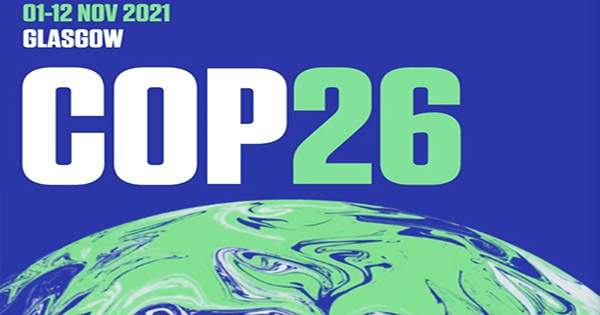The moment has finally come: the COP26 Climate Conference in Glasgow, Scotland, begins today. While there have been several conferences, agreements, and promises in recent years on the world’s climate catastrophe, this gathering is particularly significant.
In the next two weeks, you’ll no likely be bombarded with headlines and news alerts regarding COP26, so here’s a jargon-free rundown of what you actually need to know and why you should care.
The 26th “Conference of the Parties” is abbreviated as COP26. The summit, which will take place at the Scottish Event Campus in Glasgow from October 31 to November 12, 2021, will bring together delegates from all nations that have signed the UN Framework Convention on Climate Change (UNFCCC) and those that have ratified the Paris Climate Agreement. The COP26 conference was supposed to take place last year, but it was postponed owing to the COVID-19 epidemic. Representatives, leaders, and government heads from all over the globe gathering in Paris to debate and negotiate how to carry out the conditions of the Paris Climate Agreement and alleviate the climate problem in order to avoid a catastrophic future. In other words, the planet’s future is currently debated.
Over 25,000 individuals have signed up to attend, representing governments, corporations, non-governmental organizations, media outlets, and civil society organizations. Many, but not all, of the world’s heads of state, will be in Glasgow as well. China’s Xi Jinping, Russias Vladamir Putin, Brazil’s Jair Bolsonaro, Mexicos Andres Manuel Lopez Obrador, and South Africa’s Cyril Ramaphosa are among those who will not be present. Among these international leaders have stated that they are unable to fly owing to COVID-19 concerns, but given that many of them represent some of the world’s largest carbon emissions, their absence has sparked controversy.
At the COP21 summit in Paris in 2015, 91 nations plus the European Union signed the Paris Climate Agreement, which aims to keep average global temperature rises well below 2°C (3.6°F) and preferably under 1.5°C (2.7°F) over pre-industrial levels. It was a watershed moment in the effort to bring all nations together in a single cause to confront climate change.
Parties committed to meet every five years to examine collective progress and determine how they can equitably fulfill these long-term goals as part of the agreement. This will be a big topic in the COP26 meeting in a few weeks. In addition, the Paris Agreement set up $100 billion each year to assist developing nations in combating climate change. Climate injustice will be taken into account during the COP26 discussions, ensuring that wealthy countries, which have historically emitted the most greenhouse emissions, contribute the most to solving the problem while poor countries are not shortchanged.
All of the research used in these UN conferences and discussions comes from the Intergovernmental Panel on Climate Change (IPCC), an intergovernmental group tasked with presenting countries with the most up-to-date consensus on climate change data. The landmark Paris Agreement in 2015 substantially influenced the IPCC’s Fifth Assessment Report.
Since the pre-industrial period, the earth has warmed by around 1.2°C. In 2017, the IPCC released a special study on the effects of global warming of 1.5 degrees Celsius above pre-industrial levels. This determined that the objective of keeping global warming below 2°C was not stringent enough and that our ecosystems will still suffer catastrophic permanent harm.
Instead, the research stated that we should aim for a temperature rise of no more than 1.5 degrees Celsius. While climate change will occur regardless of 1.5°C global warming, it is far preferable to 2°C.
This climate conference is billed as one of the last chances we have truly address climate change, owing to the fact that the Paris Agreement’s 1.5°C objectives are rapidly approaching its expiration date. We may expect to reach or exceed 1.5°C over the next 20 years if we do not act soon, according to the latest IPCC study released in August. To have a chance of attaining this goal, the globe must decrease greenhouse gas emissions by 55 percent in the next eight years.
The globe is still a long way from meeting the Paris Agreement’s goal of limiting temperature rises to 1.5 degrees Celsius. According to a UN assessment issued last month, existing promises to reduce greenhouse gas emissions are putting the world on course for a “catastrophic” average temperature rise of 2.7°C (4.8°F). A large number of governments have already made significant commitments. As of today, 49 countries, including the European Union, have committed to a net-zero goal. Many of these agreements, however, set a net-zero goal for 2050, postponing action until beyond 2030. It is possible that this is too little, too late.
Furthermore, many of these commitments are ambiguous, and governments have not said how they plan to accomplish the goals. Some nations’ promises also differ from the legally stated national commitments, known as Nationally Determined Contributions (NDCs) that agreed upon following the Paris Agreement. All of this needs to work out, and time is running short. Intergovernmental meetings have a terrible name for producing hollow talk and little progress. “Green economy blah blah blah,” Greta Thunberg remarked in the run-up to COP26. Net-zero by 2050, blah, blah, blah, blah, blah, blah, blah, blah, All we hear from our so-called leaders is this.”
It is apparent that the time for hollow words is passed, and that deeds must now speak louder than words. “Diplomatic niceties have outlived their usefulness… “We are destined for horrific human misery if countries — notably G20 states — do not rise up and lead this effort,” warned UN Secretary-General Antonio Guterres.














